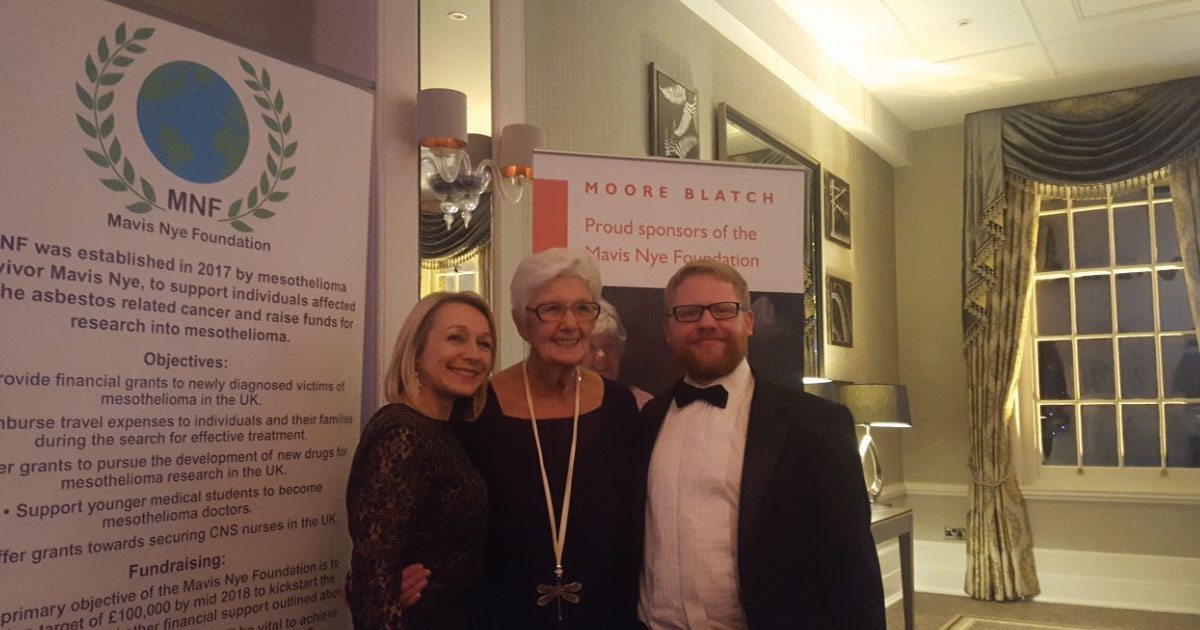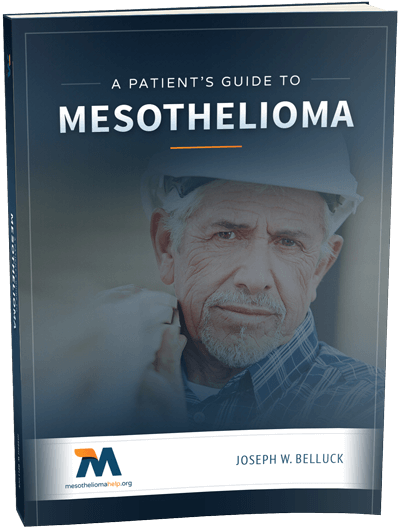Category: Research

Mavis Nye Takes Patient Empowerment to a New Level, Starts Foundation to Fund Mesothelioma Research
It has been nearly one year since Mavis Nye completed a life-saving clinical trial at the Royal Marsden in England. The 75-year-old British woman who has battled mesothelioma for the last eight years went from a frightened, sick patient lost in a medical maze, to the first UK patient to claim remission from the cancer.
Mavis fought nearly every step of the way to ensure that she got the right care at the right time that would help keep the cancer at bay and keep her alive. She has proven that a mesothelioma patient can regain her health and her life by taking control of her own care, and she showed that an empowered patient has the best chance at survival.
Throughout her fight, though, Mavis never gave up on her fellow mesothelioma warriors as she battled for care for them as well. She plans on continuing that fight for others as she takes the helm at the Mavis Nye Foundation (MNF).
“I will be leaving a wonderful legacy that was always a dream of mine to raise money for research so that I pay back for such wonderful treatment that has kept me alive!” Mavis told Mesothelioma Help.
Mavis worked with a variety of people, including Trevor Sterling, Partner for Medical Relations at Moore Blatch Solicitors of London, and one of the UK’s leading major trauma lawyers, to get the foundation off the ground.
On April 27, Sterling made the following announcement on Facebook:
“A couple of years ago I read about a wonderful lady who had miraculously won her fight against Mesothelioma (an aggressive terminal cancer). She was given 3 months to live yet 8 years on she has become the most prolific asbestos campaigner. So inspired I went to meet her at the Marsden – she and her husband Ray are the most incredible people. They deserve a legacy so I am so thrilled that we have this week established the Mavis Nye Foundation.”
The MNF gives Mavis a forum to continue all of the advocacy and education work she has been doing since diagnosed with pleural mesothelioma in 2009. Mavis, who received the prestigious British Citizen Award in the category of “Service to Healthcare” in January 2016, can now give back to the community that has cheered her on throughout her highs and lows.
“Mavis has turned her battle with mesothelioma into something positive, and is making her voice heard to educate people about this illness,” said Angela Caulfield in her nomination of Mavis to the British Citizen Award.
Mavis Nye, BCAh, now proudly adds President, Mavis Nye Foundation to her signature block. Ray Nye, Mavis’s husband who has been by her side for 57 years and has been her rock during her battle with mesothelioma, will take a place on the MNF as Vice Chairman and Trustee.
“I want people to see that you can live with a terminal illness and fight, but at the same time educate people about asbestos and the disease it causes,” said Mavis.
The Mavis Nye Foundation Supports Patients, Research and the Medical Community
Mavis has always been thankful for the medical care she received, and she credits every one of the medical team members she encountered for keeping her alive far beyond her expectations. But, she also realizes that not all patients have access to such good care.
In June 2016, Mavis completed the MK3475-28 two-year clinical trial at the Royal Marsden Hospital in London where she received the immunotherapy drug pembrolizumab, known as Keytruda in the U.S. For Mavis, the results gave her a new life, and, according to a March 10, 2017 article in The Lancet, the drug is a suitable treatment option for patients with malignant pleural mesothelioma offering a “substantial duration of response.”
“All I can say is that at The Marsden, and Dean Fennel [visiting Senior Lecturer in medical oncology at Bart’s and Cancer Research UK Clinician], they all call me the star of the immunotherapy. Jeremy Steel [Co-Director of Bart’s Mesothelioma Research] in a speech recently said that they look at my case to prove that immunotherapy can work,” said Mavis.
It is this kind of response that has Mavis enthused about “funding more trials,” championing research and encouraging young college students to take on a career in the medical profession with an eye towards caring for mesothelioma patients.
As president and founder of the foundation, Mavis will guide the organization to focus on three critical areas of mesothelioma: the patient, research, and the medical staff.
The MNF will offer the following support:
- Financial support to UK patients diagnosed with mesothelioma or other asbestos-related diseases requiring assistance to access medical treatment, in particular, experimental medical treatment.
- Grants for the advancement of laboratory and clinical research in the UK for the treatment of mesothelioma and other asbestos-related diseases.
- Assist in the treatment and care of persons suffering from mesothelioma by awarding scholarships or grants for attendance at British higher education institutions for health professionals in financial need who will focus on mesothelioma nursing in the UK.
“I have so many people contacting me about the Mavis Nye Foundation it’s just amazing how it has been accepted by others,” said Mavis. “Charities, support groups, and everyone is congratulating me.”
Many factors can influence a patient’s survival, but being empowered to find the right medical care and to proactively manage the mesothelioma is the strongest weapon in fighting the disease and improving the patient’s outcome. Mavis is living proof of that, and she is not planning on giving up on herself, or others, anytime soon.
“I’m 75 now and proud to have lived this long and I never thought 8 years ago I would,” said Mavis. “My next target is our 60th wedding anniversary in 3 years time –I want to make that.”
Work is ongoing to get the MNF website established and ready to accept donations. If you would like to make a donation to the Mavis Nye Foundation now, contact Mavis at [email protected].
Read more about Mavis and Ray’s Journey on MesotheliomaHelp:
- Mavis Nye Completes Life-Saving Clinical Trial, Leaves Mesothelioma Behind
- Clinical Trial Frees Mavis Nye of Mesothelioma
- The Man Behind the Mesothelioma Warrior: Ray Nye Discusses Caring for His Wife
- Mavis Nye Finds Her Voice and Fights for the Mesothelioma Community
Follow Mavis and Ray through the following links:
- A Diary Of A Mesowarrior Living With Mesothelioma
https://rayandmave.wordpress.com/2015/11/17/a-diary-of-a-mesowarrior-living-with-mesothelioma-scan-results-have-really-shocked/ - Onestop Mesothelioma
http://onestopmesothelioma.co.uk/index.html
Mavis donates all proceeds of her books to Mesothelioma UK to help raise funds for mesothelioma research. Order her books at Mavis and Ray’s Bookstore.
Sources :
- Mesothelioma UK
http://www.mesothelioma.uk.com/ - Mavis and Ray’s Bookstore
http://www.lulu.com/spotlight/nyeray7070 - British Citizen Award
http://britishcitizenawards.co.uk/mavis-nye/

Study Shows That Asbestos Risks Remain Decades After Industry Departs
An Italian study published back in May found that malignant mesothelioma cases tend to be concentrated around industrial facilities that use asbestos. A new Italian study finds that mesothelioma incidence near industrial areas remains high long after an asbestos-using industry ceases operations.
Asbestos is the only known cause of mesothelioma, an incurable cancer affecting the membranous lining of the lungs and abdomen. Most cases of mesothelioma are related to occupational asbestos exposure. Cement factories, shipyards, automotive plants, food processing facilities, power plants, and steel plants are among the major sources of occupational asbestos exposure.
Not all asbestos exposure, however, is directly attributable to a person’s work activities. People can also be environmentally exposed to asbestos in areas where asbestos industries operate.
One such area is Casale Monferrato in Northwest Italy, the former home of the Eternit asbestos-cement plant, which closed in 1986. An Italian court in 2012 convicted the plant’s owners of causing the asbestos-related deaths of more than 3,000 people. While many of those people worked at the Eternit plant, others merely lived near the plant.
Casale Montferro is the subject of a study published recently in Occupational & Environmental Medicine. The study authors identified 200 cases of pleural mesothelioma diagnosed in Casale Montferro residents between 2001 and 2006 in an effort to quantify the association between pleural mesothelioma and asbestos exposure.
They discovered that the odds ratio (OR, a measure of association between an exposure and an outcome) of an asbestos-exposed individual developing mesothelioma ranged from 4.4 to 62.1, with increased exposure over time resulting in a higher OR. Subjects never occupationally exposed to asbestos had a mesothelioma OR of 3.8 to 23.3, while an OR of around 2 was observed for people living in homes near buildings with large asbestos cement parts.
The findings draw attention to the fact that asbestos health risks linger in the environment long after asbestos industries vacate. In addition, they serve as a reminder that asbestos disease can occur in people who never directly handled asbestos on the job.
“Risk of [pleural malignant mesothelioma] increased with cumulative asbestos exposure and also in analyses limited to subjects non-occupationally exposed. Our results also provide indication of risk associated with common sources of environmental exposure and are highly relevant for the evaluation of residual risk after the cessation of asbestos industrial use,” write the study authors.
The Italian study has implications for America and other countries with a history of industrial asbestos use. U.S. asbestos use peaked in the mid-70s, but asbestos diseases, which have a latency period of 10-40 years or more, continue to kill an estimated 12,000-15,000 Americans.
But the United States, unlike Italy, has not banned asbestos. While both countries deal with the residual presence of asbestos-containing materials from a bygone industrial era, the United States is unique among industrialized nation for its ongoing importation and use of asbestos.
Anyone interested in taking part in the fight against asbestos should visit the EWG Action Fund website.

EWG Analysis: Asbestos Kills 12,000-15,000 Americans per Year
A new analysis by the Environmental Working Group (EWG) finds that asbestos kills significantly more Americans each year than previously estimated—and the actual asbestos death toll may be much higher.
Using data from the Centers for Disease Control and Prevention (CDC) database, EWG calculated that from 1993 to 2013, 189,000 to 221,000 people (12,000 to 15,000 per year) died from mesothelioma, lung cancer, and asbestosis in the United States.
EWG says that public records of U.S. asbestos-related deaths are imprecise, however, and that their estimate is conservative.
“As shocking as these figures are, they may be too low,” said epidemiologist and former assistant Surgeon General Dr. Richard Lemen in a press release from EWG Action Fund.
http://www.prweb.com/recentnews
“The report did not estimate deaths from the other-asbestos-related diseases. Furthermore, some studies suggest even higher lung cancer rates in asbestos-exposed workers,” said Lemen.
According to EWG, 39,870 American died from mesothelioma, an incurable cancer caused exclusively by asbestos exposure, from 1999 to 2013. Over the same period, EWG estimates that 20,317 Americans died from asbestosis, a type of lung scarring caused by asbestos fibers, while as many as 159,480 died from asbestos-related lung cancer.
In addition to deaths from these causes, it is believed that asbestos exposure can also cause cancers of the larynx, pharynx, stomach, colon, ovaries, and rectum. An older study by EWG that includes asbestos-related gastrointestinal cancer puts the number of annual U.S. asbestos deaths at around 10,000.
U.S. asbestos use peaked in the 1970s and the carcinogenic mineral fiber is no longer mined in this country, but it continues to be imported and used in a wide range of products. An EWG analysis of U.S. port records indicates that at least 8 million pounds of raw asbestos have arrived here since 2006.
EWG’s figures indicate that there was no apparent decline in asbestos deaths from 1999 to 2013. There were 2,481 mesothelioma deaths in 1999 compared to 2,686 in 2013 and a high of 2,874 in 2012. Asbestosis deaths were virtually identical in 1999 and 2013 (1,258 vs. 1,229). Both EWG’s lower and higher estimate of lung cancer deaths show increases from 1999 to 2013.
This can be attributed to the long latency period of many asbestos diseases. Mesothelioma, for example, can take 15-50 years or more to develop from the time of initial asbestos exposure.
Given the lag between asbestos exposure and disease onset, asbestos disease rates will likely remain high for years to come. One expert estimates that within the next three decades 300,000 Americans will die from asbestos.
“The only way to see the numbers of asbestos-related fatalities significantly decline among Americans is for our elected leaders to adopt an outright ban on the deadly substance,” said Sonya Lunder, author of the EWG report, “Asbestos kills 12,000-15,000 people per year in the U.S.”

Italian Study: Mesothelioma Cases Concentrated Near Asbestos-Using Industries
Italian researchers looked at the geographic distribution of malignant mesothelioma cases and found that they tend to be clustered around cement manufacturing, shipbuilding, and other industrial facilities.
A team lead by Marisa Corfiata analyzed 15,322 incident cases of malignant mesothelioma from the period 1993 to 2008 recorded by the Italian national mesothelioma registry. Subjects were interviewed and asbestos exposure—the only known cause of mesothelioma—was defined for 11,852 of 15,322 cases. Cases were then then mapped and geographic clusters identified for the Northwest, Northeast, Centre, and South & Islands regions of Italy. Finally, case clusters were identified according to one of three asbestos exposure modalities: environmental, familial, and occupational.
According to the researchers, the main sources of mesotheliomas are cement manufacturing plants and shipyards, while several case clusters were also found in the vicinity of asbestos textile facilities.
“The largest [malignant mesothelioma] clusters, per number of cases or municipalities included were found, indeed, where the biggest asbestos cement plants or shipyard facilities were located,” writes Corfiata. “Overall, it should be noted that an asbestos cement industry, an asbestos textile industry or a harbor industrial area inclusive of shipyards partially contribute to exposure of MM cases in about 75% of the clusters identified.”
Diving deeper into the numbers, the researchers note that the high number of mesothelioma cases among women in the largest asbestos-cement industry clusters may be attributable to familial exposure, or so-called “take home” exposure, which occurs when one family member brings home asbestos fibers on their body or clothing and exposes other family members. For the shipyard clusters, mesothelioma is mainly associated with naval construction and/or repair activities.
The researchers also note a number of other industrial asbestos exposure sources, including steel manufacturing plants, metal product manufacturing, oil refineries, chemical facilities, power plants, railway carriage construction and maintenance, the automotive industry, glass industry, and food processing. These are many of the same industries that have historically in the United States produced occupational asbestos exposure.
But unlike the United States, Italy has enacted a national asbestos ban. The study points out that Italian asbestos consumption peaked later in Italy than in the U.S., and, given the 35-40 year latency period of mesothelioma, “a high number of cases is still expected in Italy in the next few decades.”
Mesothelioma incidence is thought to have already peaked in the United States, but as long as the use of asbestos products remains legal in this country, the carcinogenic mineral fiber continues to pose a threat to public health. Each year in the U.S. approximately 3,000 people are diagnosed with mesothelioma, while 10,000 total death are attributed to asbestos.
You can read the full text of the Italian report “Epidemiological patterns of asbestos exposure and spatial clusters of incident cases of malignant mesothelioma from the Italian national registry” at BMC Cancer.

Expression of CD10 Enzyme May Serve as Prognostic Factor for Mesothelioma Patients
Expression of an enzyme known as CD10 in malignant pleural mesothelioma tumors correlates with more aggressive cancer cell growth and shorter survival times, according to a new study published in the Annals of Surgical Oncology.
CD10 is a zinc-dependent cell surface enzyme expressed in both normal tissue and malignant tumors. Previous studies have indicated that CD10 expression in certain malignant tumors, including malignant melanoma, predicts tumor aggressiveness. Researchers led by Dr. Kyuichi Kadota of Memorial Sloan Kettering Cancer Center in New York set out to test whether CD10, which is expressed in malignant pleural mesothelioma, can be used to predict mesothelioma patient survival.
The research team looked at 176 malignant pleural mesothelioma cases among three different tumor subtypes (148 epithelioid, 14 biphasic, and 14 sarcomatoid) in order to determine negative or positive expression of CD10. Patients whose tumors showed positive CD10 expression were found to have significantly shorter survival.
“Tumoral CD10 expression correlated with aggressive histologic types and higher miotic activity and is an independent prognostic factor for patients with malignant pleural mesothelioma,” write the study authors in the conclusion to “Tumoral CD10 Expression Correlates with Aggressive Histology and Prognosis in Patients with Malignant Pleural Mesothelioma.”
Their finding is significant because the current best mesothelioma prognostic markers—cancer stage and cancer type—are limited in how accurately they can predict patient survival outcomes. Additional prognostic factors, the authors say, are necessary to optimize mesothelioma treatment options and to better stratify patients in clinical trials.
Treatment options for mesothelioma, a highly-aggressive form of cancer associated with exposure to asbestos, include radiation, chemotherapy, and surgery. Despite improvements, however, none of these options have proven to be particularly successful, and mesothelioma prognosis remains poor. According to the study authors, the median survival for mesothelioma patients is less than two years.
In general, patients who receive a mesothelioma diagnosis while the disease is in Stage 1 or 2 have a much better chance of successful treatment. Early diagnosis, however, can be difficult due to the disease’s long latency period of 15 to 60 years and its tendency during early stages to mimic non-life threatening ailments such as the flu.
There is still no cure for mesothelioma, but new treatments have made it possible to manage it as a chronic disease, and some patients live with the disease for years. Potential new mesothelioma therapies, meanwhile, are constantly being explored. Research topics run the gamut from novel (such as gene therapy) to common (e.g. the active ingredient in vinegar).
Free Mesothelioma Patient & Treatment Guide
We’d like to offer you our in-depth guide, “A Patient’s Guide to Mesothelioma,” absolutely free of charge.
It contains a wealth of information and resources to help you better understand the condition, choose (and afford) appropriate treatment, and exercise your legal right to compensation.
Download Now